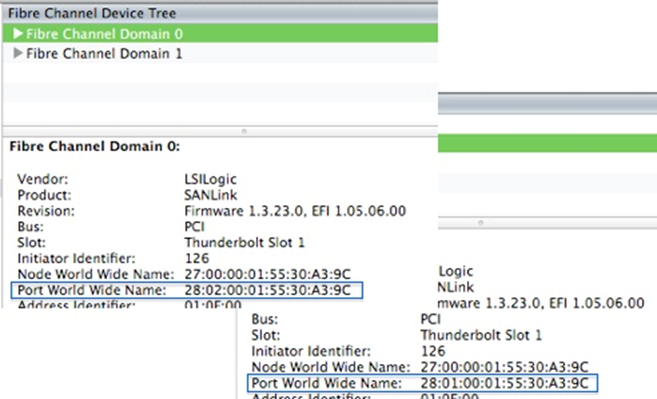When adding a client to a VTrakFS SAN you may encounter a situation where the file system volume can’t be mounted, even after adding the client to the SAN and Exports in the management GUI. The most likely reason is that all of the LUNs that comprise the file system are not visible to the client over the Fibre Channel ports.
To correct this condition, begin by opening the Mac’s System Information app and go to Fibre Channel.
Select the root Domain entry for one of the two that are cabled to the VTrak.
The SCSI Target Devices should have a Model of VTrak A3800f and the SCSI Logical Unit @ 0 should show no capacity while the SCSI Logical Unit @ 2 and @ 3 should show both a Capacity and LUN Alias.
Both cabled Domains should have the LUNs visible, but if one does not we have to fix that by adding it to the LUN Mapping table.
To do this, the first step is to get the Port World Wide Name [WWPN] for the ports that are cabled to the VTrak A3800.
For example, Fibre Channel Domain 0 has a Port World Wide Name of 28:02:00:01:55:30:A3:9C and FC Domain 1 has a WWPN of 28:01:00:01:55:30:A3:9C.

Next, use the Terminal to connect to the VTrak A3800s management CLI. Note that you must use ssh to establish a session as telnet is disabled by default.
# ssh administrator@<A3800 IP address>
The password is the same as for the GUI; the default is ‘password’.
View the LUN mapping table to see the entered initiator WWPNs with the lunmap command:
administrator@cli> lunmap
LUN Mapping Type : Initiator
LUN mapping and masking : enabled
------------------------------------------------------------------
Initiator 1 Name: 28-01-00-01-55-30-a3-9c
==================================================================
| LdId LUN | LdId LUN | LdId LUN | LdId LUN |
==================================================================
| 1 1 | 2 2 |
For this example only one initiator is listed, 28-01-00-01-55-30-a3-9c, which is the WWPN for the FC Domain 1 port. Because the other port’s WWPN is not listed it can’t see the LUNs.
To remedy this we will manually add the FC Domain 0 WWPN to the list.
The format of the command is:
lunmap –a <action> -l <Logical Drive ID list> -m <LUN to map to> -n <WWPN>
So, using our second WWPN we will match the LD and LUN values for the first WWPN:
administrator@cli> lunmap -a add -l 1,2 -m 1,2 -n 28-02-00-01-55-30-a3-9c
View the LUN mapping table again to verify that the second WWPN has been successfully entered:
administrator@cli> lunmap
LUN Mapping Type : Initiator
LUN mapping and masking : enabled
------------------------------------------------------------------
Initiator 1 Name: 28-02-00-01-55-30-a3-9c
==================================================================
| LdId LUN | LdId LUN | LdId LUN | LdId LUN |
==================================================================
| 1 1 | 2 2 |
------------------------------------------------------------------
Initiator 2 Name: 28-01-00-01-55-30-a3-9c
==================================================================
| LdId LUN | LdId LUN | LdId LUN | LdId LUN |
==================================================================
| 1 1 | 2 2 |
Now that both WWPNs are listed, the LUNs will be visible over both FC Domains, allowing the VTrakFS file system to mount.
You can use command-R to refresh the System Information, and the LUNs should now appear in both FC Domains.

